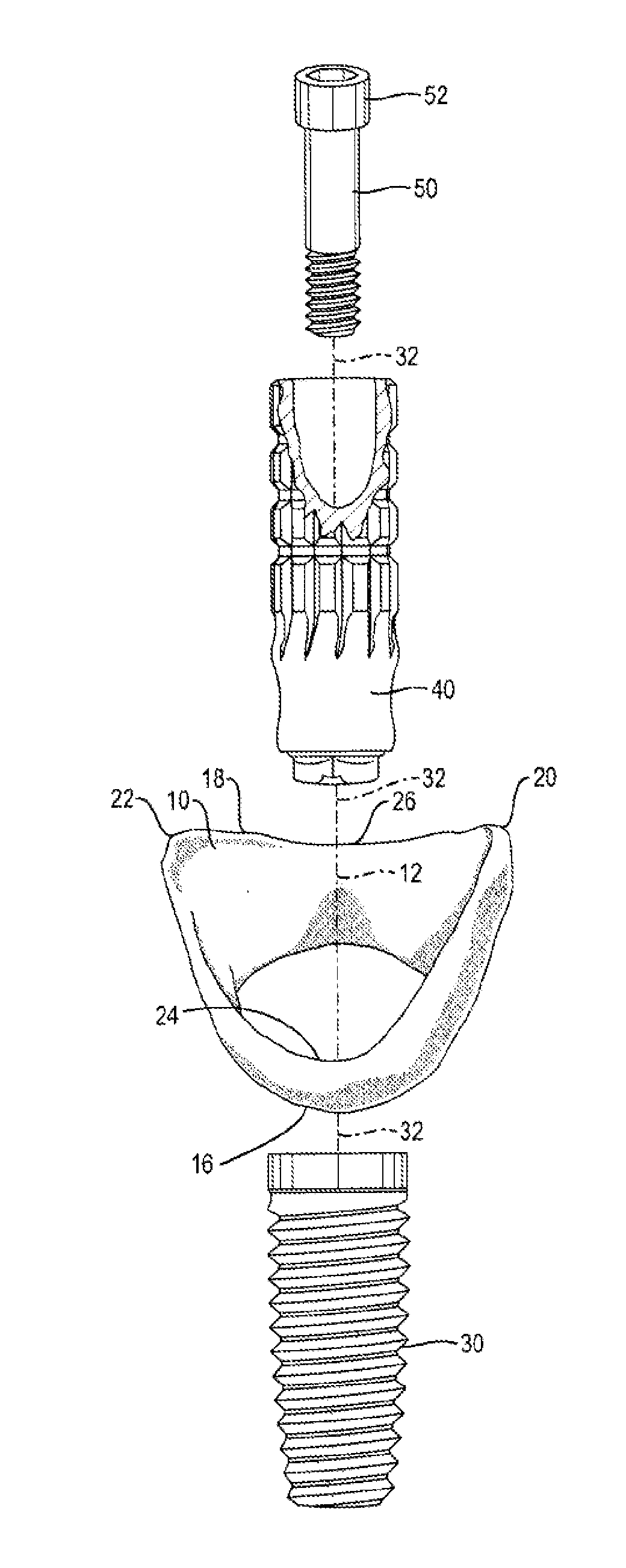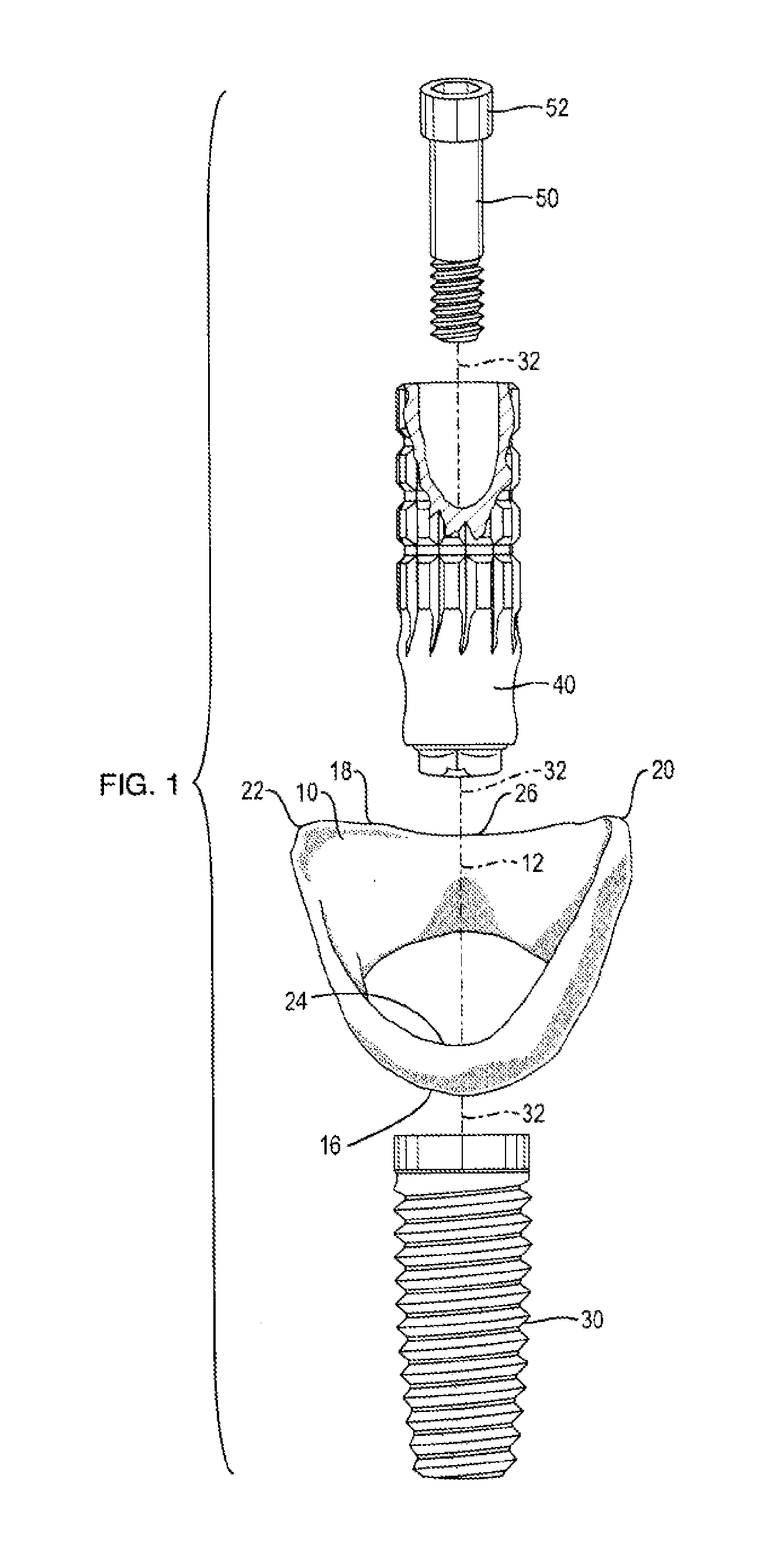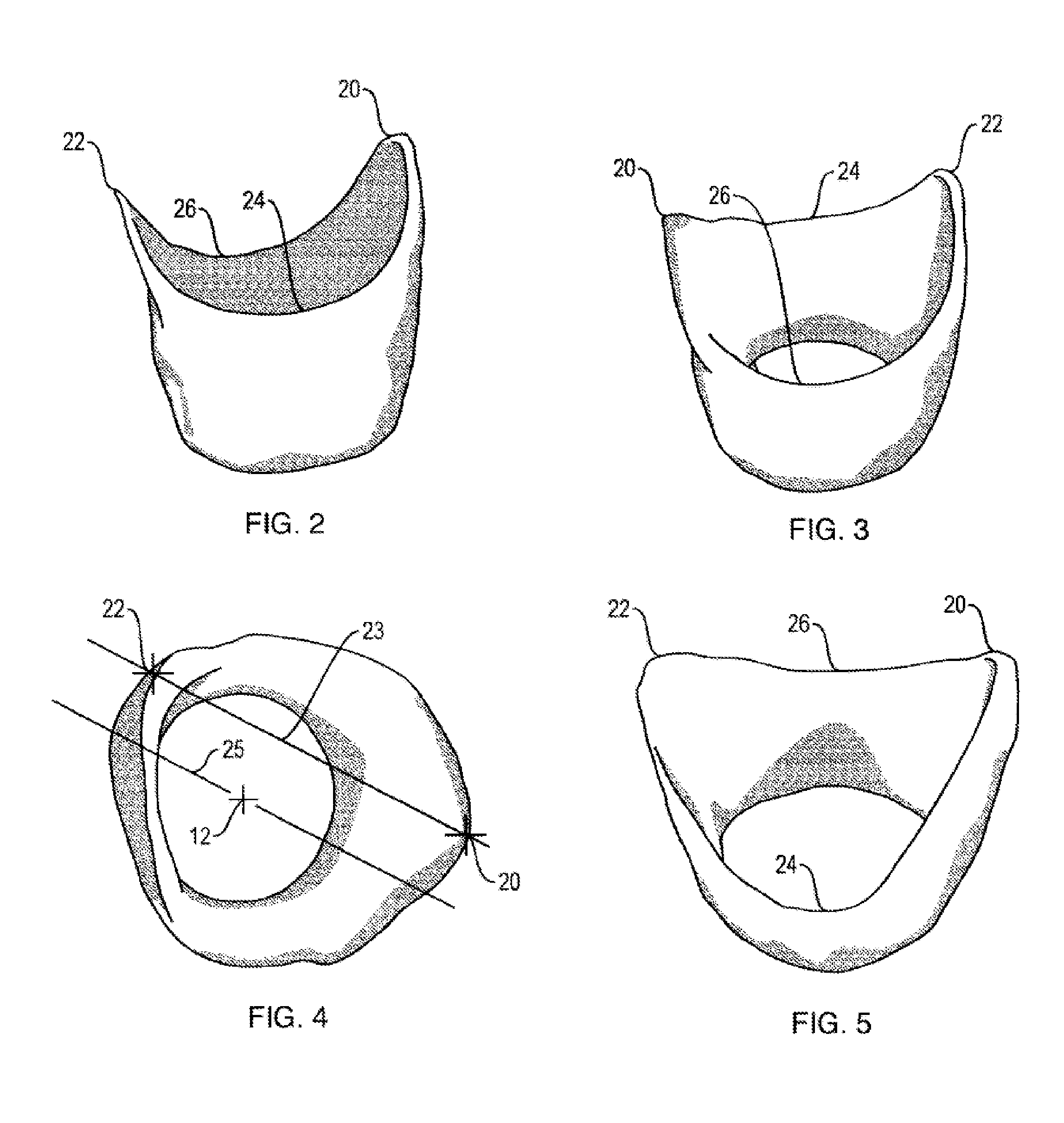As without the presence of this soft tissue biologic seal the underlying bone would be vulnerable to numerous invasions of various foreign substances.
The loss or the alternation of anatomic structures of the tissue-zone has been shown to lead to an inferior esthetic outcome in addition to causing a
potential risk of
disease for the patient.
The tooth and its attachment to the jaw is subject to numerous pathogens over the lifetime of a patient, particularly due to trauma / fracture, endodontic failure, decay, localized
periodontal disease, etc.
Gingival flap
surgery also has the known deficiency to result in bone loss from the stripping away of the
periosteum and hence the
blood supply to the bone during the reflection of a surgical flap.
It is well documented in the dental literature that gingival surgical flaps result in bone loss by the
exposure of the underlying bone.
These undesirable anatomic changes to the bone make the placement of implants more complex and increases risk for patients.
A deficiency of using
bone replacement substances is the inability to contain and protect these materials to
exposure to the
oral cavity during the critical healing phase, i.e. a fundamental inability to re-establish the all-important biologic-seal of the Tissue-Zone once a tooth is removed.
A general deficiency of using barrier membranes is the
direct exposure of a
barrier membrane that consequently lends to the inability to establish a soft tissue seal.
The
exposure of the
barrier membrane leads to plaque accumulation on the surface of the membrane that is impossible to clean.
Once membranes become exposed to the oral environment,
bacteria colonization on the surface of the membrane quickly spearheads an infection and / or failure of regeneration of bone.
The primary cause of the exposure of the membrane is a lack of a soft tissue biologic-seal after gingival flap
surgery.
The inability to re-establish a biologic-seal after the removal of a tooth has many repercussions to bone and soft tissue regeneration.
A general deficiency of the fresh
extraction site is the ability to relate the position of the overlying residual soft tissue to an implant placed immediately into a fresh bony
extraction site.
Additionally, the ability to control the vertical, horizontal and transverse positioning of an implant by the operator during immediate
implant placement into an extraction site can be difficult as it is often dictated by the remaining bone availability.
There is typically a discrepancy between the vertical, horizontal and transverse positions of the opening of the soft tissue gingival socket and the axial position of the immediate
dental implant so much so that current available implant components are ineffective.
A general deficiency of being able to relate the spatial position of the residual soft tissue gingival socket complicates the ability to fabricate a
dental prosthesis from prefabricated “stock” components.
The independent
spatial relationship of the underlying bone (or dental implant) to the overlying gingival tissues becomes difficult or impossible to relate to one another once the tooth is removed.
There are currently no predictable surgical techniques available to correct the gingival changes to vertical height and horizontal dimensional after
tooth removal.
The understanding of using a minimally invasive technique as well as re-establishing a biologic-seal after
tooth removal has been discussed but has not yet been made possible in all cases by known methods and apparatuses.
3. Difficult to re-establish a biologic-seal after numerous surgeries and the connection of the implant crown.
4. Increased cost because of multiple surgeries and prosthetic components.
5. Inability to retain the pre-existing soft tissue
anatomy prior to
tooth removal soft
tissue healing results in undesirable changes to the overlying gingival tissues that result in dramatic changes and / or reduction in the height and shape of the interdental papilla.
These changes lead to open contacts, open embrasures and affect the final dental
implant prosthesis.
The resulting open spaces collect food,
dental plaque and calculus and put the patient at greater risk to losing additional teeth in the future.
6. An inability to maintain and
record the position of the pre-treatment soft tissue gingival
anatomy found prior to tooth removal to the underlying alveolar bone and after a tooth has been removed.
This positioning of a dental implant is dictated by bone availability with a failure to be able to relate the position of the dental implant to ideal pre-treatment gingival tissues.
The delayed approach makes it impossible to position the dental implant relative to vertical, horizontal and transverse, i.e. X, Y, Z axes of the soft tissue opening prior to tooth removal.
3. Difficult to re-establish a biologic-seal after
surgery and the connection of the implant crown.
4. Difficult to re-establish soft tissue
anatomy to the state it was prior to tooth removal.
6. Increased cost because of multiple components.
7. Loss of the natural anatomic gingival contours after healing of the extraction socket making it difficult if not impossible to identify and
record the spatial position of the residual soft tissue gingival to the position of the underlying bone and / or dental implant.
Frequently roots are found to be mal-aligned resulting in significant deviations to the norm.
In fact more often then not the angulation of the root socket and the soft tissue socket are difficult to align.
Compounding this deficiency is the difficulty of vertical positioning of the immediate dental implant as it is related to the residual soft tissue socket.
Vertical discrepancies in position make the positioning of current components difficult if not impossible to use at times since they cannot relate the soft tissue anatomy of the residual soft tissue socket effectively since their shapes and orientations were not designed for the immediate soft tissue socket.
1. An inability to fully engage the entire remaining socket surface after tooth removal, thereby leaving a space (gap) between the surface of the implant and the surface of the remaining bone.
2. An inability to establish a biologic-seal to the overlying soft tissues after a tooth has been removed.
3. An inability to retain bone regenerative materials if a residual gap remains between the surface of the implant and the bone socket.
6. Inability to compensate for the vertical, horizontal and transverse discrepancy between the positions of the immediate dental implant in relation to the overlying soft tissue gingival socket after tooth removal.
7. Inability to relate the position and anatomy of the residual soft tissue socket to the clinical crown of the
extracted tooth and the relative position that the soft tissue socket has to the adjacent and opposing teeth.
8. Inability to record the peaks and valleys of the residual soft-tissue gingival socket as current
abutment designs that are not designed to mimic the residual soft tissue socket but are circular in design.
The deficiencies of achieving a predictable and esthetic long term outcome when using an immediate
implant placement protocol can all be directly attributed to the inability to establish an acceptable biologic
adaptation to create an effective biologic-seal in the tissue-zone of the remaining soft tissue socket after removal of a tooth.
The deficiencies of achieving a predictable and long term esthetic outcome of the final
implant prosthesis associated with an immediate
implant placement protocol can all be directly attributed to the inability to accurately record the
spatial relationship of the overlying soft tissue gingival socket to the underlying dental implant.
This non-concentric relationship makes it difficult if not impossible to utilize pre-fabricated stock dental implant abutments in all situations when working with immediate implant placement into a fresh tooth extraction site.
Current dental
implant abutment designs which are anatomic are based on the root anatomy and do not take into account the shape of the residual soft tissue socket
topography with a peak and valley
gingival margin, hence positioning, maintaining and recording the residual soft tissue socket anatomy is difficult if not impossible with the current “anatomic root form designs” of dental implant abutments.
Additionally, lack of an ability to record the spatial relationship of the tissue-zone (trans-gingival zone) of the soft tissue socket to the adjacent teeth and opposing arch make it difficult if not impossible to pre-fabricated stock dental implant abutments.
Since the
abutment is rigidly connected to the implant and must always be axially aligned with the
long axis of the implant, the abutment will rarely, if ever, closely engage the entire existing soft tissue socket created when a tooth has been extracted; consequently, inadequate soft tissue socket
adaptation exists.
Moreover, seldom is the axis of the implant exactly aligned with the axis of the soft tissue socket.
Also, although the abutment disclosed by this patent has raised ridges around its outer perimeter, it is symmetrical, and therefore does not mimic the asymmetric anatomy of a soft tissue socket in the gingiva of a patient from whom a tooth has been extracted.
There is no means to record the spatial position of the residual soft tissue socket to the adjacent or opposing teeth of the
extracted tooth.
Further, and importantly, these teachings only relate to delayed implant placement, not immediate placement.
The “anatomic abutment” is based on root form that does not mimic the shape of the soft tissue residual socket
topography therefore proper positioning and recording is not possible with this design.
Additionally, the prior art does not describe a hollow shell with peaks and valleys that mimic that which is found in the residual soft tissue gingival socket anatomy.
A design without the proper peaks and valleys of the transgingival zone as defined herein lacks the ability to accurately record and maintain these tissues.
This technique also fails to recognize the
advantage of independently positioning the abutment from the implant.
 Login to View More
Login to View More  Login to View More
Login to View More 


